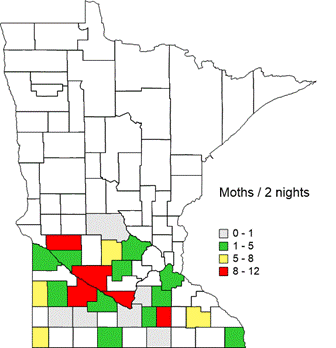2024 University of Minnesota Cooperative Black Cutworm Trapping Network
For more information: https://z.umn.edu/bcw-reporting
April 23, 2024
Greetings:

Strong southerly winds brought rain thunderstorms and black cutworm (BCW) moths to Minnesota this week and many cooperators found moths in their traps. Conditions were good for low level jet streams to transport moths from over wintering areas as far south as Texas and northern Mexico.
Significant captures on April 16 -17 (Figure 1, Table 1,2) were concentrated around Nicollet, Redwood, Renville, and Swift counties where heavy rains occurred. These large captures of 6-12/night indicate scouting for cutworms in sugarbeets as well as corn and soybeans will be important this spring. A trap in Steele County also had a significant 8 moth / 2-night capture on April 14. Degree day predictions to help time scouting for 2024 moth captures can be found in Table 2.
Two or more generations of black cutworm occur in Minnesota. Typically, only the first-generation larvae, produced by migrant moths, are damaging to agronomic crops. Fieldwork has started in many areas. Spring tillage destroys early season weed growth and reduces the field’s attractiveness to egg laying BCW moths.
For more details on Black cutworm biology, migration, scouting, and management see: black cutworm on corn
True armyworm (TAW)
Pheromone traps picked up the 1st armyworm moths of the season on April 18. Two TAW moths were captured in a Blue Earth County trap. Other traps have not captured moths but that should soon change.
This project is supported, in part, by the farm families of Minnesota and their corn check-off investment.


Until next week,
Bruce Potter
